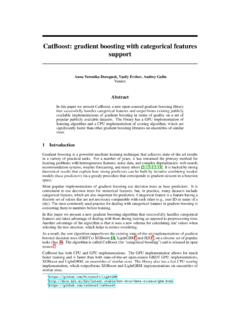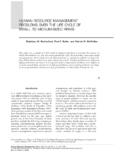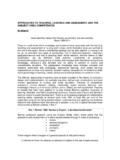Transcription of A Machine Learning Approach to Databases Indexes
1 A Machine Learning Approach to Databases IndexesAlex Beutel, Tim Kraska , Ed H. Chi, Jeffrey Dean, Neoklis PolyzotisGoogle, View, rely on indexing data structures to efficiently perform many of their coreoperations. In order to look up all records in a particular range of keys, databasesuse a BTree-Index. In order to look up the record for a single key, Databases usea Hash-Index. In order to check if a key exists, Databases use a BitMap-Index (abloom filter). These data structures have been studied and improved for decades,carefully tuned to best utilize each CPU cycle and cache available. However, theydo not focus on leveraging the distribution of data they are this paper, we demonstrate that these critical data structures are merely models,and can be replaced with more flexible, faster, and smaller Machine learned neuralnetworks. Further, we demonstrate howmachine learned indexescan be combinedwith classic data structures to provide the guarantees expected of database initial results show, that we are able to outperform B-Trees by up to44%inspeed while saving over2/3of the memory.
2 More importantly though, we believethat the idea of replacing core components of a data management system throughlearned models has far reaching implications for future systems IntroductionWhenever efficient data access is needed, index structures are the answer, and a wide variety ofchoices exist to address the different needs of various access pattern. For example, for range requests( , retrieve all records in a certain timeframe) B-Trees are the best choice. If data is only lookedup by a key, Hash-Maps are hard to beat in performance. In order to determine if a record exists,an existence index like a Bloom-filter is typically used. Because of the importance of Indexes fordatabase systems and many other applications, they have been extensively tuned over the last decadesto be more memory, cache and/or CPU efficient [3, 5, 2, 1].Yet, all of those Indexes remain general purpose data structures, assuming the worst-case distributionof data and not taking advantage of more common patterns prevalent in real world data.
3 For example,if the goal would be to build a highly tuned system to store and query fixed-length records withcontinuous integers keys ( , the keys 1 to 100M), one would not need to use a conventional B-Treeindex over the keys since they key itself can be used as an offset, making it a constantO(1)ratherthanO(logn)operation to look-up any key or the beginning of a range of keys. Similarly, the indexmemory size would be reduced fromO(n)toO(1). Of course, in most real-world use cases the datadoes not perfectly follow a known pattern, and it is usually not worthwhile to engineer a specializedindex for every use case. However, if we could learn a model, which reflects the data patterns,correlations, etc. of the data, it might be possible to automatically synthesize an index structure, index, that leverages these patterns for significant performance this paper, we explore to what extent learned models, including neural networks, can be usedto replace traditional index structures from Bloom-Filters to B-Trees.
4 This may seem counter- Professor at Brown University, but work was done while at longer technical report, including more experiments, is available at Systems Workshop at NIPS 2017, Long Beach, CA, because Machine Learning cannot provide the semantic guarantees we traditionally associatewith these Indexes , and because the most powerful Machine Learning models, neural networks, aretraditionally thought of as being very expensive to evaluate. We argue that none of these obstaclesare as problematic as they might seem with potential huge benefits, such as opening the door toleveraging hardware trends in GPUs and will spend the bulk of this paper explaining how B-Trees ( 2), Hash maps ( 3), and Bloomfilters ( 4) can be replaced withlearned Indexes . In Section 5, we will discuss how performancecan be improved with recent hardware, learned Indexes can be extended to support inserts, and otherapplications of this Range IndexWe begin with the case where we have an index that supports range queries.
5 In this case, the data isstored in sorted order and an index is built to find the starting position of the range in the sorted the position at the start of the range is found, the database can merely walk through the ordereddata until the end of the range is found. (We do not consider inserts or updates for now.) BackgroundThe most common index structure for finding the position of a key in the sorted array is a are balanced and cache-efficient trees. They differ from more common trees, like binary trees,in that at each node has a fairly large branching factor ( , 100) to match the page size for efficientmemory hierarchy usage ( , the top-k nodes of the tree always remain in cache). As such, for eachnode that is processed, the model gets a precision gain of 100. Of course, processsing a node takestime. Typically, traversing a single node of size 100, assuming it is in cache, takes approximately 50cycles to scan the page (we assume scanning, as it is usually faster than binary search at this size).
6 Learned Ranged IndexAt the core, B-Trees are models of the formf(key) pos. We will use the more common machinelearning notation where the key is represented byxand the position isy. Because we know all of thedata in the database at training time (index construction time), our goal is to learn a modelf(x) , because the dataxis sorted,fis modeling the cumulative distribution function (CDF)of data, a problem which has received some attention [4] 1 Stage 3 Stage 2 PositionKeyFigure 1: Staged modelsModel ArchitectureAs a regression problem, wetrain our modelf(x)with squared error to try topredict positiony. The question is what model archi-tecture to use forf. As outline above, for the modelto be successful, it needs to improve the precisionof predictingyby a factor greater than 100 in a lessthan 50 CPU cycles. With often many million ofexamples and needing high accuracy, building onelarge wide and deep neural network often gives notvery strong accuracy while being expensive to exe-cute.
7 Rather, inspired by the mixture of experts work [6], we build a hierarchy of models (see Figure1). We consider that we havey [0,N)and at stage`there areM`models. We train the model atstage 0,f0(x) =y. As such, modelkin stage`, denoted byf(k)`, is trained with loss:L`= (x,y)(f(f` 1(x))`(x) y)2L0= (x,y)(f0(x) y)2 Note, we use here the notation here off` 1(x)recursively executingf` 1(x) =f(f` 2(x))` 1(x). There-fore, in total, we iteratively train each stage with lossL`to build the complete model. Interestingly,we find that it is necessary to train iteratively as Tensorflow has difficulty scaling to computationgraphs with tens of thousands of typical ML models, it is not good enough to return the approximate , at inference time, when the model produces an estimate of the position, we must find theactual record that corresponds to the query key. Traditionally, B-Trees provide the location of thebeginning of the page where the key lies.]
8 For learned Indexes , we need to search around the prediction,to actually find the beginning of the , we can easily bound the error of our model such that we can use classic searchalgorithms like binary search. This is possible because we know at training time all keys the model is3 This assumes records are fixed-length. If not, the function is not the CDF, but another monotonic As such, we can compute the maximum error the model produces over all keys, and atinference time perform a search in the range[ y , y+ ]. Further, we can consider the model serror over subsets of the data. For each modelkin the last stage of our overall model, we compute itserror k. This turns out to be quite helpful as some parts of the model are more accurate than others,and as the decreases, the lookup time decreases. An interesting future direction is to minimizeworst-case error rather than average error.
9 In some cases, we have also built smaller B-Trees togo from the end of the model predictions to the final position. These hybrid models are often lessmemory efficient but can improve speed due to ExperimentsTypeConfigTotal (ns)Model (ns)Search (ns)SpeedupSize (MB)Size SavingsB-Treepage size: 642741691054% size: 1282631311310% size: 2562711171543% stage size: 10,00017826152-32% stage size: 50,00016235127-38% stage size: 100,00015236116-42% stage size: 200,00014640106-44% 2: Performance learned index vs have run experiments on 200M web-logrecords with complex patterns created byschool holidays, hourly-variations, specialevents etc. We assume an index over thetimestamps of the log records ( , an indexover sorted, unique 32bit timestamps). Weused a cache-optimized B-Tree with a page-size of 128 as the baseline, but also evaluated other page sizes. As the learned range index weused a 2-stage model (1st stage consist of 1 linear model, 2nd stage consist of varying number oflinear models).
10 We evaluated the Indexes on an Intel-E5 CPU with 32GB RAMwithouta of our experiments can be seen in Figure 2. We find that learned Indexes are significant fasterthan B-Tree models while using much less memory. This results is particular encouraging as the nextgeneration of TPUs/GPUs will allow to run much larger models in less Point IndexIf access to the sorted items is not required, point Indexes , such as hash-maps, are commonly hash map works by taking a functionhthat mapsh(x) pos. Traditionally, a good hashfunction is one for which there is no correlation between the distribution ofxand positions. Weconsider placing ourNkeys in an array withmpositions. Two keys can be mapped to the sameposition, with probability defined by the birthday paradox, and in this case a linked list of keys isformed at this location. Collisions are costly because (1) latency is increased walking through thelinked list of collided items, and (2) many of themslots in the array will be unused.










